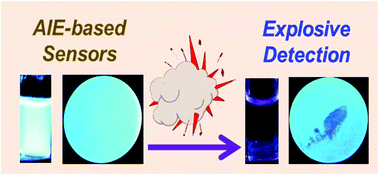Aggregation-induced emission (AIE)-active polymers for explosive detection
Abstract
Explosive detection has been receiving much attention for homeland security and global anti-terrorism. Most explosives are organic nitro-group-containing compounds. Numerous analytical methods have been applied for explosive detection, including mass spectrometry, X-ray imaging, ion mobility spectroscopy, and so on. However, these analytical methods are always time-consuming, expensive and inconvenient for practical applications. Fluorescence spectroscopy sensing technologies have provided an alternative detection method, but an aggregation-caused quenching (ACQ) effect of non-AIE based fluorescent materials limits their potential. Aggregation-induced emission (AIE) is, however, considered as an ideal solution to effectively overcome the above-mentioned ACQ effect, and AIE-active polymeric materials have been extensively applied for explosive detection. This review is to summarize the latest developments of AIE-active polymeric materials for the explosive detection in a more exhaustive and systematic way. First, the physics and chemistry of AIE-active polymers and mechanisms of explosive detection are overviewed. Then, the synthesis of AIE-active conjugated and non-conjugated polymers and their explosive detection are summarized with a special emphasis on establishing a relationship between the structures of AIE-active polymers and their sensing performance. At the end, perspectives and outlooks of AIE-active polymers for explosive detection are commented on.



 Please wait while we load your content...
Please wait while we load your content...